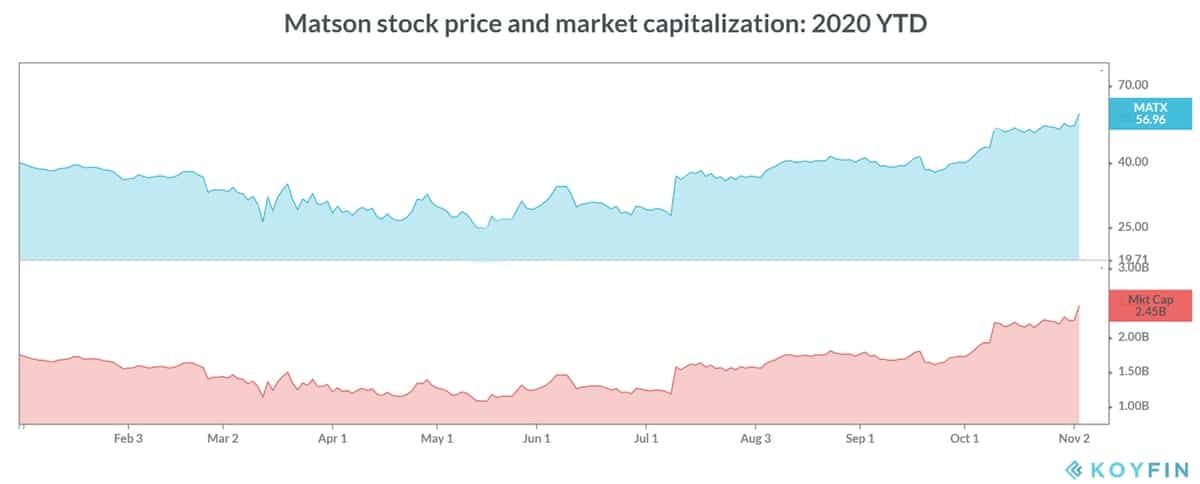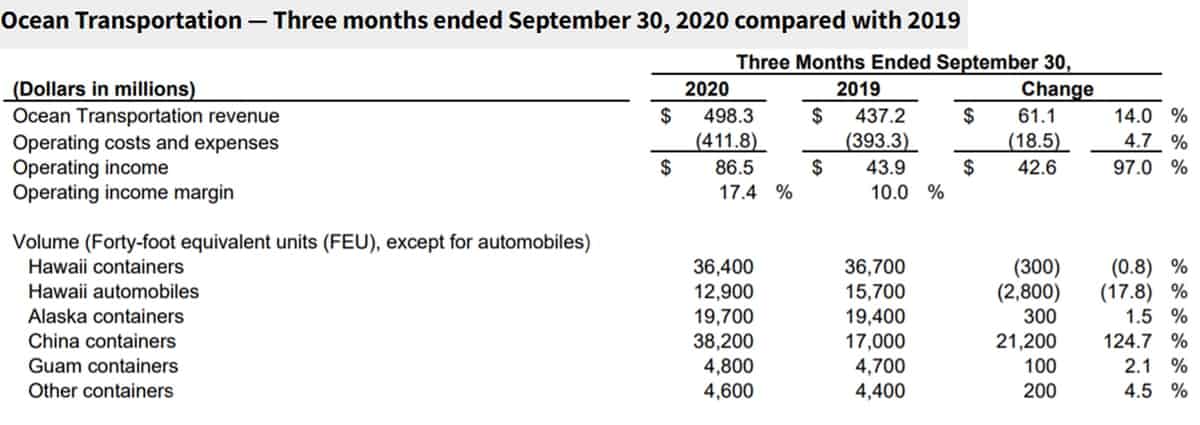“To give you a sense of the demand right now, we are turning away — each week — more cargo than we are carrying,” revealed Matson CEO Matt Cox, referring to the scramble for slots on his company’s two China-U.S. services.
During a conference call with analysts Monday after market close, Cox provided a frontline view of the torrid bookings, import drivers and tightening bottlenecks on the trans-Pacific container trade.
“This could end in a few weeks or it could continue all the way into February to the [Chinese] Lunar New Year. Nobody really knows exactly how and when this will end,” said Cox.
Holiday cargoes are still coming
There are rising fears of a so-called “shipageddon” scenario for holiday shipments in which cargoes do not make it across the Pacific on time. Cox didn’t say anything to assuage such fears.
“What typically happens is that sort of by the end of October, most of what is going to make its way into the holiday-season shopping cycle will have arrived. That’s not what we’re seeing,” he warned.
“We’re seeing significant congestion in Asia. Although I’m not talking about Matson, we’re seeing cargo that wants to get on a ship that’s being rolled [pushed back to a subsequent sailing]. And we’re seeing the other international ocean carriers put in additional extra loaders [ships not in the normal service rotation]. This is not a typical season.
“There’s such demand for cargo. Many of our customers can’t keep up with the demand and cargo is back-ordered. For all of those reasons, we’re expecting to see the season extended. To when is the big question.”
Inventory restocking cargoes are still coming
As previously reported by FreightWaves, investment bank Jefferies issued an exceptionally bullish report on Sept. 30 entitled “Get ready for the biggest restocking cycle on record.” Then, on Oct. 14, investment bank Evercore ISI released a survey finding that 90% of consumer-business respondents said their inventory levels were either “too low” or “a little too low.”
The takeaway from these reports: U.S. businesses are not even close to replenishing depleted inventories. This, on top of holiday cargoes, would boost trans-Pacific volumes in Q4 2020 and possibly into Q1 2021.
Cox cited the restocking factor. “A significant amount of inventory restocking across many industries is needed to keep pace with the elevated consumption trends and manage through any further disruptions,” he affirmed. “Inventories were depleted shortly after the pandemic hit and companies have been playing catch-up ever since.”
The Matson CEO said that liner customers were also seeking to increase inventories above normal levels for two reasons. First, “to avoid disruption this fall and winter from any COVID-related lockdowns.” And second, as part of a secular shift from the pre-COVID just-in-time model to “a more resilient inventory model.”
Cox offered a specific example. “Demand for key household items such as dishwashers, refrigerators, washers and dryers has been so strong since the pandemic hit that there are key shortages in many models and those shortages are expected to last into 2021,” he said.
E-commerce continues to push imports higher
Yet another reason for the intense strength in the trans-Pacific eastbound trade is the COVID-induced shift from in-store to e-commerce sales.
According to Cox, “Since the start of the pandemic in the U.S. in early March, there has been a seismic shift in e-commerce activity. It is estimated that at least four to six years’ worth of e-commerce sales growth was pulled forward into 2020.”
E-commerce’s need for speed is driving more traffic to the Asia-West Coast route and, in particular, to premium express services such as the CLX and CLX+ services offered by Matson.
“With the ease of an e-commerce transaction and the time saved, e-commerce growth is expected to remain robust even as COVID-19 restrictions become less stringent over time,” said Cox, who emphasized, “E-commerce wants and needs an expedited transit.”
This also affects inventory strategies, which in turn affect import volumes. Cox said that inventory management is evolving “to increase inventory of fast-moving items in the end markets where consumption is likely the greatest.”
West Coast port congestion is worsening
West Coast port congestion is yet another stress on trans-Pacific trade. Here too Cox confirmed the issue.
“In the ports, with increased volume comes increased time to offload and increased turn times at the terminals. This has had an impact on the availability of equipment. It has also led to berthing delays of vessels,” he reported, describing trucking conditions as “chaotic.”
“We’re seeing some very busy hectic congestion on the U.S. West Coast. There’s a lack of empty equipment, not die Matson but in the market. There’s a lack of chassis. There are shortages of [port] labor. There are disruptions in rail. And I can’t say when that will end.”
Stock rises as profits nearly double
It has been a terrible year in general for U.S.-listed shipping stocks, with one giant exception: Matson (NYSE: MATX). Its stock is up 48% year-to-date. Shares were up 10% on Tuesday.
Matson’s market capitalization has risen to $2.48 billion. That makes it by far the largest ocean shipping equity in the U.S. stock market. The next largest player, tanker owner Euronav (NYSE: EURN), is not even close. Euronav’s market cap is $1.55 billion, around two-thirds the size of Matson’s.
After market close Monday, Matson reported net income of $70.9 million for Q3 2020, almost double Q3 2019 earnings of $36.2 million. Earnings per share of $1.63 topped the consensus forecast of $1.58 per share.
Matson is primarily a domestic Jones Act operator serving Hawaii and Alaska — two markets that held up surprisingly well despite COVID impacts on tourism. But the spotlight is squarely on Matson’s two China services.
“Ocean transportation had a very strong quarter and was primarily led by our China service,” said Cox. Year-on-year, Matson’s 3Q 2020 China-U.S. volume was up 125%. Click for more FreightWaves/American Shipper articles by Greg Miller
MORE ON THE TRANS-PACIFIC TRADE: Holiday ‘shipageddon’ update: Container sector scrambling: see story here. Mounting evidence that container spike could last into 2021: see story here. Container slots sell out, risking holiday ‘shipageddon’: see story here. U.S. import bonanza could extend into 2021 on ‘record’ restocking: see story here.












